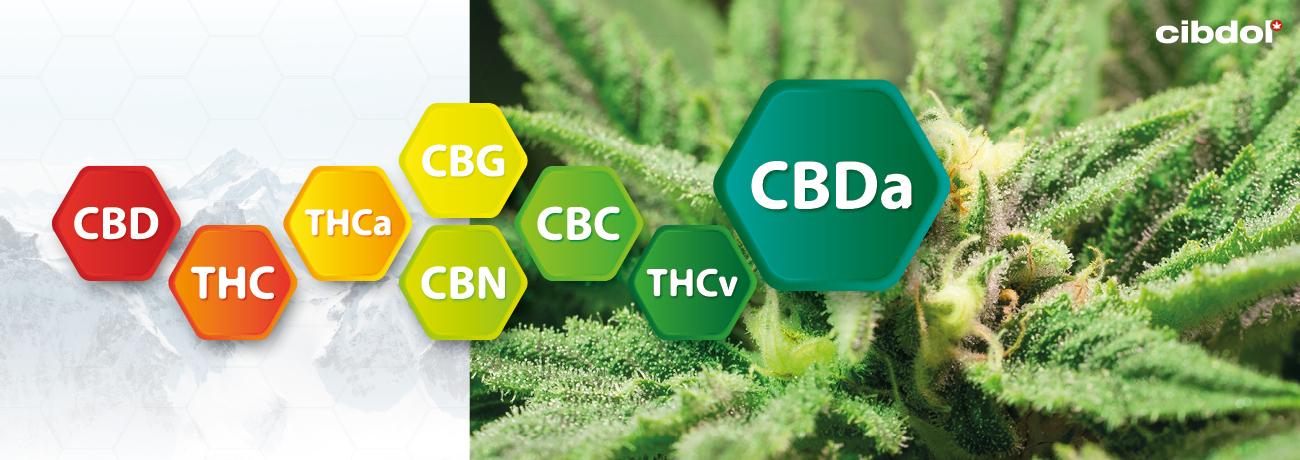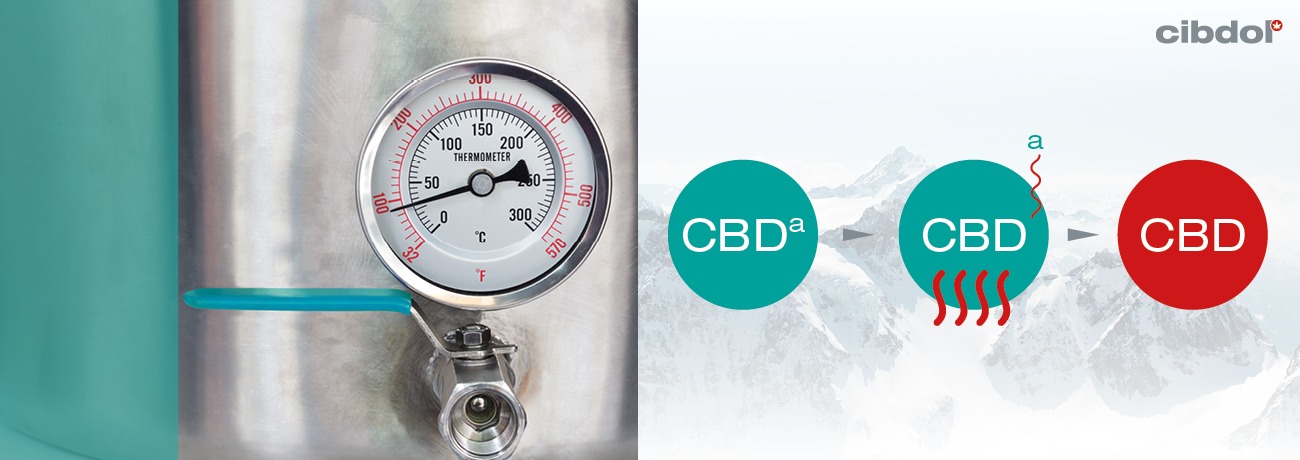Cannabidiolic Acid (CBDA): Everything You Need to Know

CBDA is one of over a hundred cannabinoids found in Cannabis sativa L. The compound is an acid precursor to CBD, but that doesn't mean it lacks potential of its own. Keep reading to learn more about this lesser-known cannabinoid.
What is CBDA?
CBDA, or cannabidiolic acid as it is technically known, exists inside cannabis and hemp plants. It's a natural compound only present inside living plant matter, as it quickly turns to CBD when exposed to heat (more on that shortly). And while you may not have heard much about CBDA, rest assured, the compound is slowly proving its worth in scientific circles.
Moreover, without cannabidiolic acid, we would never have CBD, the incredibly versatile wellness compound we all know and love. But where exactly does CBDA come from, and why have so few people heard of it? To answer that question, we first need to take a step back and look at the cannabinoid family as a whole.
Where does CBDA come from?
Inside the hemp plant lives a diverse family of well over a hundred different cannabinoids. We don't have to worry about extracting them all at once, as they don't all exist simultaneously or in similar ratios. Instead, the cannabinoid family starts as a single compound, CBGA, during the earliest stages of hemp's life cycle.
Once the plant is older, CBGA binds with an acid compound, splitting itself into three different cannabinoids. This is where we say hello to CBDA, CBCA, and THCA, the newest members of the cannabinoid family. There are residual traces of CBGA floating around, but the lion’s share of the plant's chemical structure now belongs to these three acid molecules.
CBDA decarboxylation
Our humble hemp plant is reaching maturity, making it a prime candidate for creating CBD oil. However, there's very little CBD in raw hemp flowers. Instead, CBDA is converted into CBD when exposed to high temperatures during vaporization, cooking, or extraction. This process is known as decarboxylation.
The "acid" part of CBDA comes from a carboxyl group on the molecule, consisting of one carbon, one hydrogen, and two oxygen atoms. Hence, CBDA is known as a carboxylic acid. This group is ejected from the molecule during decarboxylation, leaving behind CBD.

What is the difference between CBDA and CBD?
We wouldn't have CBD without CBDA, but there's much more to the acidic version than simply being a precursor cannabinoid. With that in mind, here are some differences worth clarifying:
• As mentioned, CBDA only exists in significant levels in raw plant material.
• Both CBDA and CBD appear to act on the endocannabinoid system when consumed, but there's more research to support CBD’s application.
• There are far more CBD products available, largely due to the difficulty of isolating significant levels of CBDA. Some full-spectrum hemp extracts may contain trace amounts of CBDA.
• On a chemical level, CBD is more stable (as it's missing the carboxyl group), meaning high-quality CBD products should stay intact longer. CBDA, on the other hand, will diminish faster, regardless of a product's quality.
• Initial research suggests CBDA has a far greater binding affinity than CBD for certain serotonin receptors. CBDA may also act on receptors supposedly unique to CBD (COX-2), and both compounds appear to activate TRP channels to some degree.
How does CBDA work?
Now that we know where CBDA comes from and what makes it different from CBD, it's time to dig a little deeper into the binding mechanics and receptor activation mentioned above.[1]
CBDA primarily interfaces with the body via the endocannabinoid system (ECS) and its receptors. However, researchers still don't understand the potential of these interactions fully. Unfortunately, studies into the compound remain at the earliest stages, as CBDA's acidic nature makes it notoriously difficult to isolate in large quantities. Still, here's what they've uncovered so far about its mechanism of action.
CBDA: receptor activation and enzyme inhibition
Initial studies suggest CBDA shows some binding affinity for various receptors in the body. It could have a far greater affinity for 5-HT1A serotonin receptors (up to 100 times more than CBD), which modulate memory, mood, sleep, nausea, and more.[2]
The second notable interaction is CBDA's potential inhibition of the COX-2 enzyme. Cyclooxygenase-2 is one of the many enzymes linked to our body's inflammatory process.
What are the effects of CBDA?
We should, again, highlight that research into CBDA is in the preliminary stages, with much more to discover about its potential influence and practical applications. That said, here are some areas in which CBDA is currently being tested:
• CBDA and anxiety: Drugs designed to target 5-HT receptors can help to modulate a variety of mood disorders. Interestingly, CBDA appears to bind to the 5-HT1A receptor with 100-fold greater affinity than CBD.[3]
• CBDA and nausea: Research published in the British Journal of Pharmacology pitched CBDA against a model of motion-induced vomiting in shrews and nausea in rats.[4]
• CBDA and inflammation: Research published in the journal Drug Metabolism & Disposition looked to determine CBDA’s impact on an inflammatory enzyme known as COX-2.[5] However, when researchers removed the carboxyl group through methylation, CBDA lost its potential to target COX-2. Thus, researchers state that the whole structure of CBDA is important, a trait that could set it apart from CBD in this regard.
• CBDA and cancer cells: Research published in the Journal of Pharmacology and Experimental Therapeutics tested various cannabinoids, including CBDA, on a panel of tumour cell lines,[6] while a 2012 paper examined the potential link between CBDA and an invasive line of breast cancer cells. However, researchers were quick to note that future research is needed to determine the exact effects of CBDA.[7]
• CBDA and COVID-19: A 2021 in-vitro (outside of the human body) study tested CBDA and CBGA against the "entry of live SARS-CoV-2 into cells". Researchers are hopeful the cannabinoids could "make for a much more challenging environment for SARS-CoV-2".[8]
As you can see from the research above, interest in CBDA is significant, and that's merely based on what we know so far. If anything, the animal and cell studies above highlight an urgent need for further clinical investigation. Fortunately, that day may come sooner than we think as cannabinoid research ramps up worldwide.
Browse the Cibdol store to experience the potential influence of CBDA with dozens of full-spectrum products, including capsules and oils. Or, to learn more about the vast world of cannabinoids, visit our CBD Encyclopedia for everything you need to know.
FAQ
- Is CBDA legal?
- Unlike the psychotropic cannabinoid THC, there are no outright restrictions on CBDA. Thus, the cannabinoid appears in legal products throughout Europe and the United States.
- Is CBDA the same as CBD?
- CBDA and CBD differ not only on a chemical level, but also in how they affect receptors and enzymes inside the human body.
[1] Formato M, Crescente G, Scognamiglio M, et al. (‒)-cannabidiolic acid, a still overlooked bioactive compound: An introductory review and preliminary research. Molecules (Basel, Switzerland). https://www.ncbi.nlm.nih.gov/pmc/articles/PMC7321064/. Published June 5, 2020. Accessed January 17, 2022. [Source]
[2] Russo EB. Cannabis therapeutics and the future of neurology. Frontiers in integrative neuroscience. https://www.ncbi.nlm.nih.gov/pmc/articles/PMC6200872/. Published October 18, 2018. Accessed January 17, 2022. [Source]
[3] Russo EB. Cannabis therapeutics and the future of neurology. Frontiers in integrative neuroscience. https://www.ncbi.nlm.nih.gov/pmc/articles/PMC6200872/. Published October 18, 2018. Accessed January 17, 2022. [Source]
[4] Pertwee RG, Rock EM, Guenther K, et al. BPS Publications. British Pharmacological Society | Journals. https://bpspubs.onlinelibrary.wiley.com/doi/10.1111/bph.14073. Published December 5, 2017. Accessed January 17, 2022. [Source]
[5] K; TSMKYIW. Cannabidiolic acid as a selective cyclooxygenase-2 inhibitory component in Cannabis. Drug metabolism and disposition: the biological fate of chemicals. https://pubmed.ncbi.nlm.nih.gov/18556441/. Published 2008. Accessed January 17, 2022. [Source]
[6] Ligresti A, Moriello AS, Starowicz K, et al. Antitumor activity of plant cannabinoids with emphasis on the effect of cannabidiol on human breast carcinoma. Journal of Pharmacology and Experimental Therapeutics. https://jpet.aspetjournals.org/content/318/3/1375. Published September 1, 2006. Accessed January 17, 2022. [Source]
[7] Takeda S, Okajima S, Miyoshi H, et al. Cannabidiolic acid, a major cannabinoid in fiber-type cannabis, is an inhibitor of MDA-MB-231 breast cancer cell migration. Toxicology Letters. https://www.sciencedirect.com/science/article/abs/pii/S0378427412012854?via%3Dihub. Published September 7, 2012. Accessed January 17, 2022. [Source]
[8] van Breemen RB;Muchiri RN;Bates TA;Weinstein JB;Leier HC;Farley S;Tafesse FG; R. Cannabinoids block cellular entry of SARS-COV-2 and the emerging variants. Journal of natural products. https://pubmed.ncbi.nlm.nih.gov/35007072/. Published 2022. Accessed January 18, 2022. [Source]
[1] Formato M, Crescente G, Scognamiglio M, et al. (‒)-cannabidiolic acid, a still overlooked bioactive compound: An introductory review and preliminary research. Molecules (Basel, Switzerland). https://www.ncbi.nlm.nih.gov/pmc/articles/PMC7321064/. Published June 5, 2020. Accessed January 17, 2022. [Source]
[2] Russo EB. Cannabis therapeutics and the future of neurology. Frontiers in integrative neuroscience. https://www.ncbi.nlm.nih.gov/pmc/articles/PMC6200872/. Published October 18, 2018. Accessed January 17, 2022. [Source]
[3] Russo EB. Cannabis therapeutics and the future of neurology. Frontiers in integrative neuroscience. https://www.ncbi.nlm.nih.gov/pmc/articles/PMC6200872/. Published October 18, 2018. Accessed January 17, 2022. [Source]
[4] Pertwee RG, Rock EM, Guenther K, et al. BPS Publications. British Pharmacological Society | Journals. https://bpspubs.onlinelibrary.wiley.com/doi/10.1111/bph.14073. Published December 5, 2017. Accessed January 17, 2022. [Source]
[5] K; TSMKYIW. Cannabidiolic acid as a selective cyclooxygenase-2 inhibitory component in Cannabis. Drug metabolism and disposition: the biological fate of chemicals. https://pubmed.ncbi.nlm.nih.gov/18556441/. Published 2008. Accessed January 17, 2022. [Source]
[6] Ligresti A, Moriello AS, Starowicz K, et al. Antitumor activity of plant cannabinoids with emphasis on the effect of cannabidiol on human breast carcinoma. Journal of Pharmacology and Experimental Therapeutics. https://jpet.aspetjournals.org/content/318/3/1375. Published September 1, 2006. Accessed January 17, 2022. [Source]
[7] Takeda S, Okajima S, Miyoshi H, et al. Cannabidiolic acid, a major cannabinoid in fiber-type cannabis, is an inhibitor of MDA-MB-231 breast cancer cell migration. Toxicology Letters. https://www.sciencedirect.com/science/article/abs/pii/S0378427412012854?via%3Dihub. Published September 7, 2012. Accessed January 17, 2022. [Source]
[8] van Breemen RB;Muchiri RN;Bates TA;Weinstein JB;Leier HC;Farley S;Tafesse FG; R. Cannabinoids block cellular entry of SARS-COV-2 and the emerging variants. Journal of natural products. https://pubmed.ncbi.nlm.nih.gov/35007072/. Published 2022. Accessed January 18, 2022. [Source]












